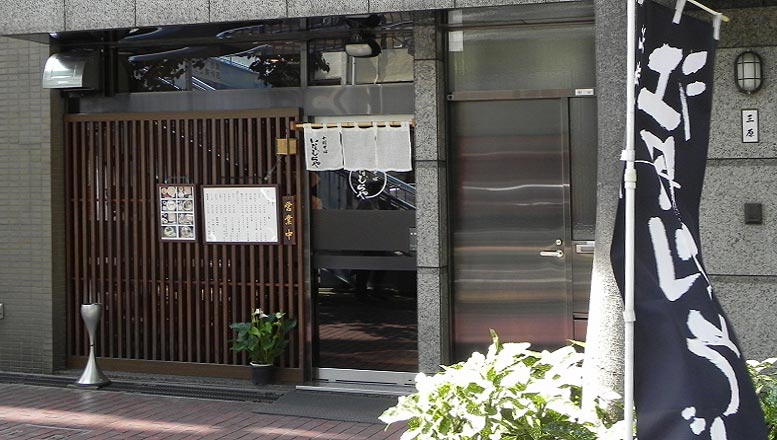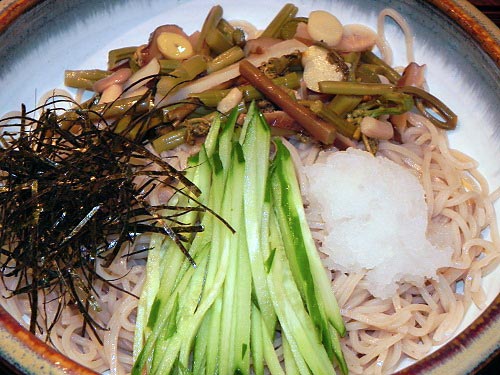- Yummy top
- Eateries and restaurants
- Uoyu - lunch restaurant
- Kanno
- Tokachiya
- Kitchen Nankai - Jinbocho
- Lamb Meat Tender
- Fujiyoshi - tempura restau.
- Enda - Japanese blue crab
- Fukuda - globefish pot
- Sugimoto
- Fuushi
- Soba restaurant
- Shinano - Akabanebashi
- Juwari-soba Inamuraya
- Ando and Korin
- Toranomon Sunaba
- Izakaya
- subLime and Kakinoki
- Donburi-bachi
- Renka
- Yoshida
- Daini-Chikarashuzo
- Sasagin
- Mugiya - soba izakaya
- Fukube
- Sasashin in Ningyo-cho
- Foreign cuisine
- Pizza Piazza
- Atelier de Fromage
- La Piccola Tavola
- Milieu - salad lunch
- Cafe Moskow - Spanish bar
- Sin Tong Kee
- Sekaihanten
- Miscellaneous
- Cheese & champignon party
- Natural Cheese Contest
- Donburi - rice bowl dish
- Home cooking
- Aji no nanban-zuke
- Spaghetti Carbonara
- Curry rice
Juwari-soba Inamuraya
Juwari-soba Inamuraya
Toranomon 1-19-7, Minato-ku, 151-0001 TokyoTel: 03-3501-4743
Open from 11:00 to 14:30
Saturdays, Sundays and Holidays closed

Inamuraya with a banner "Ebanbetsu soba"
It is not easy to make noodles from soba flour only, because soba flour is not easy to stick together. Usually wheat, taro and other flour is mixed into buckwheat flour so that the dough is sticky enough to form noodles. Generally speaking, the higher the percentage of soba flour, the better is the taste of soba noodles. Usually the expression "nippachi" is used as a sales slogan for good quality soba. This literally means "two eight" and indicates that as much as 80 percent of the dough is from buckwheat flour. If 80% is good enough, 100% soba is expected to be super delicious, but it is not something everybody can make.

Cold soba noodles with wild vegetables (and grated radish and thinly cut seaweed and cucumber)

Street in which Inamuraya stands
 Therefore, 100% soba flour noodle is really something if it is available. This noodle shop "Inamura-ya" succeeded in making it with the help of a special machine. A company in Morioka sells special machines to make 100% soba noodles and boasts that it can also train unskilled people to open a professional soba restaurant within a week with the help of its soba-machine!
Therefore, 100% soba flour noodle is really something if it is available. This noodle shop "Inamura-ya" succeeded in making it with the help of a special machine. A company in Morioka sells special machines to make 100% soba noodles and boasts that it can also train unskilled people to open a professional soba restaurant within a week with the help of its soba-machine! There might be different opinions about the quality of the machine made noodles. I found it fairly good and probably better than average handmade soba noodles, though the texture of soba noodles does not exactly correspond to my taste.
Another appealing point of Inamuraya is that it uses buckwheat harvested in the Etanbetsu area in Hokkaido. Hokkaido produces about 40% of the total buckwheat production of Japan. Ebanbetsu, a part of Asahikawa city, is especially famous for its high quality buckwheat, because its temperature extremely fluctuates annually: very high in summer - highest temperature is over 35 degree Celsius - and very low in winter - lowest temperature is lower than minus 35 degree Celsius. This large temperature fluctuation raises the quality of buckwheat.


 Anyhow, the combination of good quality buckwheat flour and a high-tech machine is the basis of Inamuraya and I am satisfied with the result. The facade of Inamura-ya looks rather elegant and passersby might believe that this is an expensive restaurant. That is not the case. If you open the door, you find a vending machine to buy tickets - a typical installation of popular restaurants. There are not many choices: only 6 kinds of cold soba and seven kinds of warm soup soba. Their prices are also reasonable - the simple soba dish costs 600 yen - and their quantity is more than enough. Inamuraya has only 10 seats at a counter. An older woman takes care of the guests in a very skilled but personal and friendly way. A cook and an assistant are working in the kitchen.
Anyhow, the combination of good quality buckwheat flour and a high-tech machine is the basis of Inamuraya and I am satisfied with the result. The facade of Inamura-ya looks rather elegant and passersby might believe that this is an expensive restaurant. That is not the case. If you open the door, you find a vending machine to buy tickets - a typical installation of popular restaurants. There are not many choices: only 6 kinds of cold soba and seven kinds of warm soup soba. Their prices are also reasonable - the simple soba dish costs 600 yen - and their quantity is more than enough. Inamuraya has only 10 seats at a counter. An older woman takes care of the guests in a very skilled but personal and friendly way. A cook and an assistant are working in the kitchen. Since we have an extremely hot summer this year, I order only cold soba these days. My favorites are "cold soba with grated taro" and "cold with wild vegetables" (both 850 yen). Inamura-ya now belongs to my favorite lunch restaurants.
Since we have an extremely hot summer this year, I order only cold soba these days. My favorites are "cold soba with grated taro" and "cold with wild vegetables" (both 850 yen). Inamura-ya now belongs to my favorite lunch restaurants.